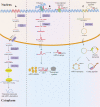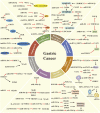Non-Coding RNAs in Gastric Cancer: From Malignant Hallmarks to Clinical Applications
- PMID: 34805143
- PMCID: PMC8595133
- DOI: 10.3389/fcell.2021.732036
Non-Coding RNAs in Gastric Cancer: From Malignant Hallmarks to Clinical Applications
Abstract
Gastric cancer (GC) is one of the most lethal malignancies worldwide. However, the molecular mechanisms underlying gastric carcinogenesis remain largely unknown. Over the past decades, advances in RNA-sequencing techniques have greatly facilitated the identification of various non-coding RNAs (ncRNAs) in cancer cells, including microRNAs (miRNAs), long non-coding RNAs (lncRNAs), and circular RNAs (circRNAs). Accumulating evidence has revealed that ncRNAs are essential regulators in GC occurrence and development. However, ncRNAs represent an emerging field of cancer research, and their complex functionality remains to be clarified. Considering the lack of viable biomarkers and therapeutic targets in GC, further studies should focus on elucidating the intricate relationships between ncRNAs and GC, which can be translated into clinical practice. In this review, we summarize recent research progress on how ncRNAs modulate the malignant hallmarks of GC, especially in tumor immune escape, drug resistance, and stemness. We also discuss the promising applications of ncRNAs as diagnostic biomarkers and therapeutic targets in GC, aiming to validate their practical value for clinical treatment.
Keywords: biological functions; biomarker; gastric cancer; non-coding RNAs; targeted therapy.
Copyright © 2021 Chen, Ping, Xu, Wang, Jiang, Xiong, Zhang, Yu and Xiong.
Conflict of interest statement
The authors declare that the research was conducted in the absence of any commercial or financial relationships that could be construed as a potential conflict of interest.
Figures


References
-
- Amaravadi R. K., Kimmelman A. C., Debnath J. (2019). Targeting Autophagy in Cancer: Recent Advances and Future Directions. Cancer Discov. 9 (9), 1167–1181. 10.1158/2159-8290.CD-19-0292 - DOI - PMC - PubMed
Publication types
LinkOut - more resources
Full Text Sources
Miscellaneous

